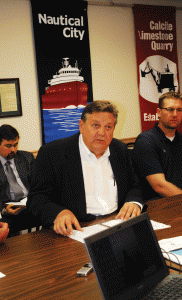Coast Guard regulation raises concerns about sanctuary expansion

by Peter Jakey Managing Editor
U.S. Rep. Dr. Dan Benishek and local industry leaders appeared at a public hearing regarding the expansion of the Thunder Bay National Marine Sanctuary from 448 square miles to 4,300 square miles. That would include the Lake Huron waters off Presque Isle County.
There are 60 days to comment on the completed draft environmental impact statement, and during that time, public hearings were conducted in Rogers City, Alpena and Harrisville this week. Proposed expansion has been on the table since 2006.
There has been little, if any opposition to expansion over the years. In fact, the Rogers City Council approved a resolution of support at their July 2 meeting.
However, an issue came to light within the last week and spurred company executives from Carmeuse Lime & Stone and Lafarge-Stoneport, as well as others from the region, to appear at the Rogers City hearing to express their concerns about a U.S. Coast Guard regulation prohibiting ballasting in marine sanctuaries and anchoring.
“We support the expansion of the sanctuary, so long as it can be accomplished in a way that doesn’t have a negative impact on the local commerce in Rogers City, and the surrounding communities,” said Ray LeClair, Carmeuse’s area operations manager of the Great Lakes Division. “We are concerned that expanding the sanctuary could increase the areas where ballasting is not permitted, which includes the commercial docks here in Rogers City, as well as the dock at Presque Isle.”
Ballast or de-ballasting is a process by which seawater is taken in and out of the ship when the ship is at the port or at sea. It ensures its trim, stability and structural integrity.
“When the vessel is loaded, it is designed to be loaded with cargo. When it is not loaded with cargo, to displace where that cargo should be, we have to put water in the boat. That water has to be discharged when water comes in,” said Jayson Toth of the Interlake Steamship Company, who spoke during the hearing. He said 90 percent of ballasting occurs in port.
“To not be able to ballast ships effectively, we cannot load or discharge ships in our ports. So, effectively you would shut us down if we expand,” said Paul Rogers, Alpena Lafarge plant manager.
Sanctuary superintendent Jeff Gray indicated that the Coast Guard regulation was not brought to their attention until the public comment period got underway.
LeClair mentioned the lives lost on the Bradley and Cedarville, and said vessel safety “is so sensitive to us, and I’m sure to a number of surviving family members of the sailors who did not return home that went to sea.”
Benishek wanted to attend one of three hearings this week, so his comments would be included in the record. “While I support the overall expansion plan, I remain concerned that this plan may have some unintended consequences on the shipping industry,” said Benishek.
“Although the environmental impact statement showed no impact on commercial shipping, I am concerned that the report failed to review new ballast discharge guidelines.”
LeClair said another concern is vessels anchoring in a sanctuary. That too is prohibited, but the Federal Register does not provide details about the restrictions, he said.
“Here in Rogers City at the Port of Calcite, it is quite common to see a vessel(s) anchored off shore throughout the shipping season,” said LeClair.
He further said that any restriction placed on the marine transportation network because of the sanctuary boundaries could have a direct impact on the Calcite plant and the 125 plus local jobs, as well as the number of spinoff jobs in the community. LeClair also said it could affect the U.S. steel industry.
“We want to make sure, as we go forward with this, it does not affect any current vessel operations,” said Toth.
“As a member of the board of directors of the Michigan Port Collaborative, we have no interest in putting Calcite out of business, or Stoneport, or Alpena,” said Rogers City mayor Beach Hall. “I think this is totally in the ‘where did this idea come from’ category.”
Dave Nelson, Stoneport plant manager added that it would be “very detrimental if it went through as is.”
The expansion area covers all of U.S. waters off of Presque Isle, Alpena
“We are simply asking that vessels that for decades have operated in certain ways be allowed to continue to do so,” said LeClair. “These operations do not pose a threat to our waters nor would they undermine the purpose of the sanctuary in any way.
“In fact, allowing these modern vessels to continue to operate safely; only adds to the story of the importance of Great Lakes maritime commerce that this sanctuary has been specially designed to tell.”
Gray said sanctuary officials have been in contact with U.S. Sen. Carl Levin’s office to come up with a solution.
Gray said, “That is why this is a draft, so we can address these issues.”
